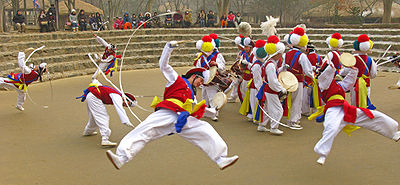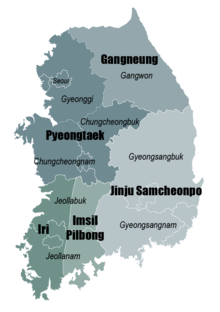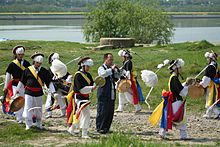- Pungmul
-
Pungmul ([ˈpʰuːŋmul] poong-muul) is a Korean folk music tradition that includes drumming, dancing, and singing. Most performances are outside, with tens of players, all in constant motion. Pungmul is rooted in the dure (collective labor) farming culture. It was originally played as part of farm work, on rural holidays, at other village community-building events, and in shamanistic rituals. Today it has expanded in meaning and is also used in political protest and as a performing art form.
Older scholars often describe this tradition as nongak ([ˈnoŋak] nong-ahk), a term meaning "farmers' music" whose usage arose during the colonial era (1910–45). The Cultural Heritage Administration of South Korea uses this term in designating the folk tradition as an Important Intangible Cultural Property. Opposition from performers and scholars toward its usage grew in the 1980s because colonial authorities attempted to limit the activity to farmers in order to suppress its use and meaning among the colonized. It is also known by many synonymous names throughout the peninsula.
Drumming is the central element of pungmul. Each group is led by a kkwaenggwari (small handheld gong) player, and includes at least one person playing janggu (hourglass drum), buk (barrel drum), and jing (gong). Wind instruments (t'aepyongso, also known as hojeok, senap, or nalari, and nabal) sometimes play along with the drummers.
Following the drummers are dancers, who often play the sogo (a tiny drum that makes almost no sound) and tend to have more elaborate—even acrobatic—choreography. Finally, japsaek (actors) dressed as caricatures of traditional village roles wander around to engage spectators, blurring the boundary between performers and audience. Minyo (folksongs) and chants are sometimes included in pungmul, and audience members enthusiastically sing and dance along. Most minyo are set to drum beats in one of a few jangdan (rhythmic patterns) that are common to pungmul, sanjo, p'ansori, and other traditional Korean musical genres.
Pungmul performers wear a variety of colorful costumes. A flowery version of the Buddhist kkokkal is the most common head-dress. Advanced performers sometimes wear sangmo, which are hats with long ribbon attached to them that players can spin and flip in intricate patterns by moving their heads.
Contents
Classification
Pungmul (Hangul: 풍물; Hanja: 風物) was first recognized as an Important Intangible Cultural Property in 1966 under the title nongak sipicha (농악십이차, "twelve movements of farmers' music"). The designation was changed to simply nongak in the 1980s in order to accommodate regional variations.[1] The Cultural Heritage Administration currently recognizes five regional styles of the tradition, each named for its center of activity, under Important Intangible Cultural Property no. 11: South Gyeongsang province (designated in 1966); Pyeongtaek nongak, from Gyeonggi province (1985); North Jeolla province (1985); Gangwon province (1985); and Honam region encompassing the two Jeolla provinces.[3] In this region, the designations jwado (left) for Imsil Pilbong and udo (right) for Iri are determined according to geomantic principles. Looking southward from the "center" (Seoul, the capital), udo indicates "west", and jwado indicates "east".[2] Comparative studies between the two styles brought about the development of stereotypes among professional groups. Honam jwado became known for its varying formations and rapid rhythmic patterns, while honam udo was generally seen as having slow but graceful rhythmic patterns.[4]
History
Early development
Suppression and unrest
During the Joseon dynasty, this folk tradition was the primary mode of musical expression for a majority of the population.[5] Many scholars and performers today claim that the term nongak (Hangul: 농악; Hanja: 農樂) was introduced in order to suppress its broad use and meaning among the Korean population.[6]
Revival
True public support for pungmul improved little in the decade following its recognition and financial backing from the government. There was a lack of interest among Koreans who abandoned their traditional customs after moving to the cities. This phenomenon was coupled with the introduction of Western-style concert halls and the growing popularity of Western classical and popular music.[7]
In 1977, prominent architect Kim Swoo Geun designed the Konggansarang (공간사랑), a performance hall for traditional Korean music and dance located in the capital, and invited artists and scholars to organize its events.[8] During the performance center's first recital in February 1978, a group of four men led by Kim Duk-soo and Kim Yong-bae, both descendants of namsadang troupe members, performed an impromptu arrangement of Pyeongtaek (utdari) pungmul with each of its four core instruments. Unlike traditional pungmul, this performance was conducted in a seated position facing the audience and demonstrated a variety of rhythms with great flexibility. It was well received by audience members, and a second performance was soon held three months later. Folklorist Sim U-seong, who introduced both men to the Konggansarang club, named the group SamulNori (Hangul: 사물놀이; Hanja: 四物놀이), meaning "playing of four objects".[9] Samul nori eventually came to denote an entire genre as training institutes and ensembles were established throughout South Korea and Japan.[10] Usage of the term nongak was retained in order to distinguish traditional pungmul from this new staged and urbanized form.[11]
Music
Instruments
Repertoire
Dance
Costuming
Formations
International exposure
Pungmul is played in many Korean American communities across the United States. There are several community-based pungmul groups in many cities, including Oakland, Los Angeles, Chicago, New York City, Baltimore, etc. College-based groups also exist at the University of California (Berkeley, Los Angeles, Davis, San Diego, Santa Barbara, Irvine), Stony Brook University, Columbia University, New York University(New York University Rhythmic Impulse), Massachusetts Institute of Technology, Harvard University, Yale University, the University of Chicago, the University of Pennsylvania, Cornell University, the University of Illinois at Urbana-Champaign, University of Buffalo, Binghamton University, Syracuse University, Stanford University, The University of Toronto, and so on.
Even though pungmul has rapidly gained popularity, it is, however, difficult to learn and play in the US. One of the most primary reasons for the difficulty is the lack of resources and teachers. In Korea, there are local centers for preserving and teaching indigenous styles of pungmul, and anyone with an interest can visit those centers to learn pungmul and improve his/her skills. However, most pungmul groups in the US have to rely on a limited number of pungmul players who happen to live in the vicinity of those groups.
Coupled to the difficulty of finding a pungmul teacher or master, the lack of information on pungmul is also a major problem for the pungmul activity in the U.S. It prohibits many people from studying and learning pungmul even for themselves.
Last but not least, obtaining or purchasing the pungmul instruments is also major difficulty for playing pungmul. Currently, most Korean folk instruments are not available in the US, so they have to be purchased directly from Korea. In most cases, a few members of a pungmul group would bring one or two pungmul instruments, after visiting their home or relatives in Korea. pungmul groups so far had to reply on such occasional trips to Korea for the replenishment or purchase of the new instruments. Naturally, through such a method, only a limited number of instruments can be brought in, and sometimes the pungmul group has to go on with broken instruments for a long time, until one of its member makes a trip to Korea.
The lack of teachers/masters and resources and the difficulty of obtaining instruments are some of the most apparent obstacles of the pungmul activity in the U.S. There are also subtle, yet important and unique issues that the pungmul groups in the US have to resolve. As mentioned before, pungmul has been accepted and gained popularity in many Korean-American communities across the US during the past few years. However, playing Pungmul in the U.S. now takes on quite a different meaning from playing Pungmul in Korea or playing it 10 or 5 years ago.
For the second generation of Korean-American pungmul players, who constitute a large fraction of the pungmul group, pungmul is a medium through which they can experience the cultural heritage of their parents' motherland and a way of discovering their identities and the roots. For the 1.5 generation or the recent immigrants from Korea, pungmul is a source of joy and pride about their motherland's culture. For the people from other cultural and ethnic origin, pungmul provides an easy access to learn and experience parts of Korean culture. However, Pungmul's power of bringing people together has not been fully realized yet. Even though pungmul has had much positive influence on the Korean-American community in the past, there are still many gaps that have to be bridged. The cultural and generational gap between the first and the second generations of Korean-Americans is one such example.
See also
- Important Intangible Cultural Properties of Korea
- Korean dance
- Music of Korea
- Namsadang, itinerant performance troupe having pungmul in its repertoire
- Samul nori, traditional percussion genre derived from multiple pungmul styles
Notes
- ^ Hesselink 2006, p. 10
- ^ a b Hesselink 2006, p. 11
- ^ Park 2000, p. 65
- ^ Park 2000, p. 66
- ^ Hesselink 2006, p. 2
- ^ Hesselink 2006, p. 15
- ^ Hesselink 2004, pp. 408–409
- ^ Park 2000, p. 177
- ^ Park 2000, p. 178
- ^ Hesselink 2004, pp. 410
- ^ Park 2000, p. 25
References
- Bussell, Jennifer L. (1997) (B.A. thesis), A Life of Sound: Korean Farming Music and its Journey to Modernity, Department of Anthropology, University of Chicago, archived from the original on 3 July 2007, http://web.archive.org/web/20070703031718/http://www.kycc.net/NPN/Documents/bussell_thesis.doc, retrieved 10 June 2011.
- Hesselink, Nathan (1999), "Kim Inu's 'P'ungmulgut and Communal Spirit': Edited and Translated with an Introduction and Commentary", Asian Music (Society for Asian Music) 31 (1): 1–34, ISSN 0044-9202.
- Hesselink, Nathan (2004), "Samul nori as Traditional: Preservation and Innovation in a South Korean Contemporary Percussion Genre", Ethnomusicology (Society for Ethnomusicology) 48 (3): 405–439, ISSN 0014-1836.
- Hesselink, Nathan (2006), P'ungmul: South Korean Drumming and Dance, Chicago Studies in Ethnomusicology, Chicago, I.L.: University of Chicago Press, ISBN 978-0-226-33095-2.
- Hesselink, Nathan (2007), "Taking Culture Seriously: Democratic Music and Its Transformative Potential in South Korea", The World of Music (University of Bamberg) 49 (3): 75–106, ISSN 0043-8774.
- Hesselink, Nathan (2009), "'Yŏngdong Nongak': Mountains, Music, and the Samulnori Canon", Acta Koreana (Keimyung University) 12 (1): 1–26, ISSN 1520-7412.
- Kwon, Donna Lee (2001), "The Roots and Routes of Pungmul in the United States", Music and Culture (Korean Society for World Music) 5: 39–65, ISSN 1229-5930, archived from the original on 27 August 2008, http://web.archive.org/web/20080827185325/http://kycc.net/NPN/Documents/USpungmul_2001.doc, retrieved 10 June 2011.
- Park, Shingil (2000) (Ph.D. thesis), Negotiating Identities in a Performance Genre: The Case of P'ungmul and Samulnori in Contemporary Seoul, Department of Music, University of Pittsburgh, ISBN 978-0-599-79965-3.
External links
- P'ungmul nori at the Virtual Instrument Museum of Wesleyan University
- Poongmul.com, a network of pungmul groups in the United States
- Pungmul on YouTube, very well made video from Bucheon, Korea
Categories:- Korean traditional music
- Important Intangible Cultural Properties of South Korea
Wikimedia Foundation. 2010.








